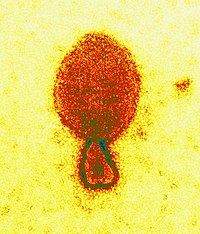
Photo from wikipedia
Abstract Bats of the genus Pteropus (Pteropodidae), colloquially known as flying foxes, are recognized as the natural reservoir of Hendra virus, a zoonotic paramyxovirus responsible for mortality in horses and… Click to show full abstract
Abstract Bats of the genus Pteropus (Pteropodidae), colloquially known as flying foxes, are recognized as the natural reservoir of Hendra virus, a zoonotic paramyxovirus responsible for mortality in horses and humans. Some previous studies have suggested that physiologic and ecologic factors promote Hendra virus infection in flying foxes, and by extension, spillover to horses and humans. However, the impact of Hendra virus infection on relevant physiologic biomarkers in flying foxes has not been measured. Over 12 mo in eastern Australia, we captured and sampled 446 individual black flying foxes (Pteropus alecto), a putative primary reservoir host species, and measured a suite of hematologic, plasma biochemistry, and urinary biomarkers. All mean hematologic and biochemical values in both Hendra virus–positive and virus–negative cohorts were within the published reference ranges for black flying foxes. We found no association between Hendra virus infection (as indicated by PCR detection of Hendra virus RNA) and biomarkers for nutritional stress, reproductive stress, or extreme metabolic demand. However, we identified associations between several other biomarkers and Hendra virus infection, which may partly elucidate the physiologic effects of Hendra virus infection in flying foxes. Our findings highlight the need for critical evaluation of putative risk factors for infection in flying foxes and provide insights for future epidemiologic studies of Hendra virus and related viruses in the Pteropus species.
Journal Title: Journal of Wildlife Diseases
Year Published: 2017
Link to full text (if available)
Share on Social Media: Sign Up to like & get
recommendations!